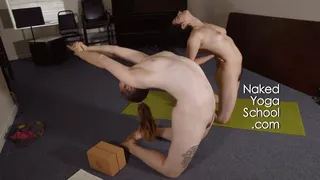Review and rate your favorite studios!
Naked Prenatal Tantric Yoga 1: Partner work
My Rating:
Related Categories
Related Keywords
Description
(All Levels)
Getting into an upside down position can help a breech, an oblique (diagonal lie), or posterior baby reposition themselves into the head-down orientation for birth. During a forward-leaning inversion, the uterus briefly hangs by the cervical ligaments; returning to an up-right position relaxes the ligaments. Babies that are not in a head-down anterior position OR malpositioning of the uterus often put pressure on pelvic nerves, causing pain in the back, groin, and legs. Notice wrist options. These asana also help release lower back and hips which, due to the additional ...
Description
(All Levels)
Getting into an upside down position can help a breech, an oblique (diagonal lie), or posterior baby reposition themselves into the head-down orientation for birth. During a forward-leaning inversion, the uterus briefly hangs by the cervical ligaments; returning to an up-right position relaxes the ligaments. Babies that are not in a head-down anterior position OR malpositioning of the uterus often put pressure on pelvic nerves, causing pain in the back, groin, and legs. Notice wrist options. These asana also help release lower back and hips which, due to the additional ...

Formats Available
Comments
Formats Available
Related Clips from Naked Yoga School

Naked Chanting Mantra 7: Lokah Samastah Sukhino Bhavantu
20 min
Not Rated

ASMR: Naked Beauty 1: Naked Coconut Oil Pulling!
18 min
Not Rated

Naked Jump Rope Meditation 1: Leap into the Calm!
11 min
Not Rated

Naked Yoga for Anxiety!
70 min
Not Rated
Related Clips From Other Studios

SADIE HOLMES WANTS TO BECOME A BALLOON
Studio: Roxie Rae Fetish
10 min

A Piggyback For Preggy
Studio: Raptures Fetish Playground
8 min

